UPSC Exam > UPSC Notes > Geography for UPSC CSE > Cheat Sheet: Deserts
Cheat Sheet: Deserts | Geography for UPSC CSE PDF Download
Definition and Classification
- A desert is an area that receives less than 250 mm of rainfall per year.
- Deserts can be hot or cold, but all are arid or semi-arid in nature.
Types of Deserts
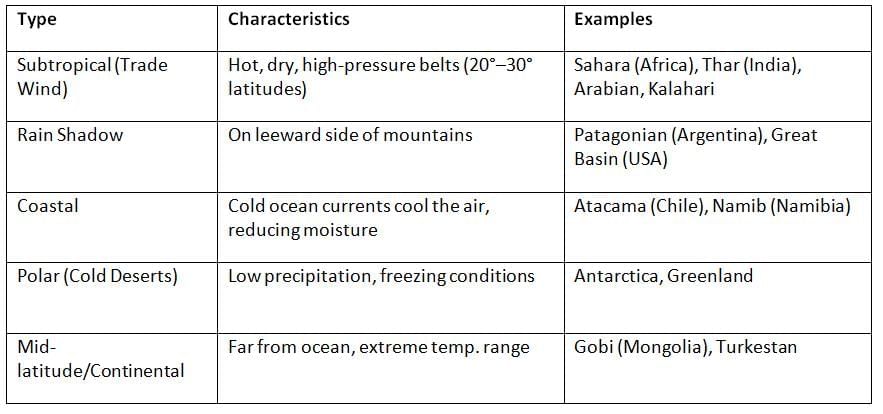
World’s Major Deserts (With Continents)
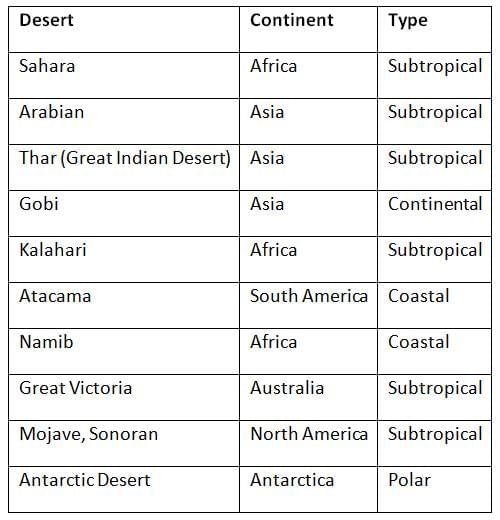
Desert Landforms
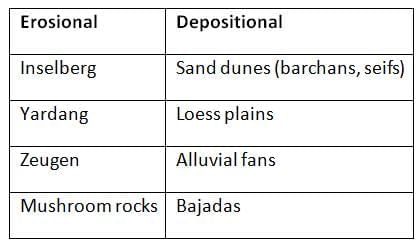
Yardang = wind-sculpted ridges
Barchan = crescent-shaped dune, windward side steep
Indian Desert – Thar Desert
- Located in Rajasthan, partly in Gujarat, Haryana, Punjab.
- Bounded by Aravalli hills (east) and Indus river (west).
- Rainfall: <200 mm, mostly in short monsoon spells.
- Soil: Sandy, saline; poor in organic matter.
- Vegetation: Xerophytic (acacia, cactus), sparse grasses.
Human Geography
- Densely populated for a desert (over 80 people/km²).
- Irrigation Projects: Indira Gandhi Canal (transforms some areas into arable land).
- Livelihood: Pastoralism, subsistence farming, handicrafts.
- Threats: Desertification, overgrazing, salinity
Vegetation & Biodiversity in Deserts
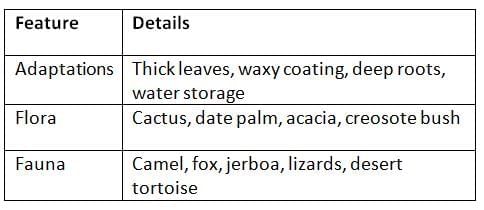
Why Are Deserts Found in Subtropical Regions?
- High-pressure zones due to descending dry air from Hadley Cells.
- Trade winds blow dry air toward the equator, preventing cloud formation.
- Often on western sides of continents, near cold ocean currents.
UPSC Tip: Link with Climatology – Subtropical High Pressure, Walker Circulation, Ocean Currents.
Environmental Concerns
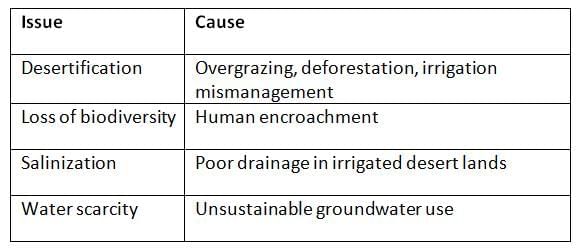
- UNCCD (United Nations Convention to Combat Desertification) – major global treaty on this issue.
Mains-Friendly Keywords
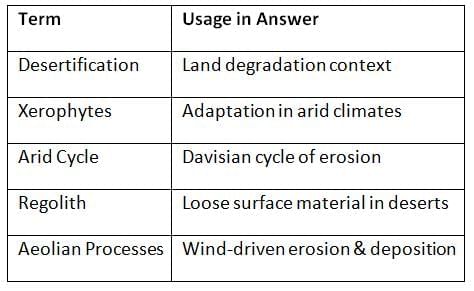
The document Cheat Sheet: Deserts | Geography for UPSC CSE is a part of the UPSC Course Geography for UPSC CSE.
All you need of UPSC at this link: UPSC
|
175 videos|624 docs|192 tests
|
FAQs on Cheat Sheet: Deserts - Geography for UPSC CSE
| 1. What are the main types of deserts classified based on their characteristics? |  |
Ans. Deserts are primarily classified into four main types:
1. <b>Subtropical Deserts</b>: Characterized by high temperatures and low rainfall, found around 20° to 30° latitude. Examples include the Sahara and the Arabian Desert.
2. <b>Cold Deserts</b>: These deserts experience cold winters and are usually located at higher latitudes. The Gobi Desert is a notable example.
3. <b>Coastal Deserts</b>: Found along coastlines, these deserts have mild temperatures and can have some moisture from ocean currents. The Atacama Desert is an example.
4. <b>Rain Shadow Deserts</b>: Created by mountain ranges that block moisture-laden winds, leading to arid conditions on the leeward side. The Great Basin Desert in the USA is a prime example.
| 2. What are the notable features of the Thar Desert in India? |  |
Ans. The Thar Desert, also known as the Great Indian Desert, is located in northwestern India and extends into Pakistan. Key features include:
1. <b>Climate</b>: It has a hot desert climate, with extreme temperatures ranging from very hot in summer to cool in winter.
2. <b>Geography</b>: Characterized by sand dunes, rocky outcrops, and sparse vegetation.
3. <b>Biodiversity</b>: Home to a unique array of flora and fauna adapted to arid conditions, including species like the Indian gazelle and various reptiles.
4. <b>Cultural Significance</b>: The desert is inhabited by various communities with rich traditions, including the Rajputs and the Bhils.
| 3. Why are deserts predominantly found in subtropical regions? |  |
Ans. Deserts are predominantly found in subtropical regions due to:
1. <b>High Pressure Systems</b>: These areas are often dominated by high-pressure systems that inhibit cloud formation, leading to low precipitation.
2. <b>Trade Winds</b>: The descending air from the Hadley cells in these latitudes creates dry conditions.
3. <b>Distance from Oceans</b>: Many subtropical deserts are located far from moisture sources, which contributes to their aridity.
4. <b>Geographical Features</b>: Mountain ranges can block moisture-laden winds, further enhancing desert conditions.
| 4. What are the significant environmental concerns related to deserts? |  |
Ans. Significant environmental concerns related to deserts include:
1. <b>Desertification</b>: The process where fertile land becomes desert due to various factors, including climate change and unsustainable land use.
2. <b>Biodiversity Loss</b>: Increased human activity can threaten the unique flora and fauna adapted to desert environments.
3. <b>Water Scarcity</b>: Over-extraction of groundwater and poor water management can lead to severe water shortages.
4. <b>Climate Change Impacts</b>: Changes in temperature and precipitation patterns can exacerbate existing challenges in desert regions.
| 5. What are the distinct landforms typically found in desert regions? |  |
Ans. Distinct landforms in desert regions include:
1. <b>Sand Dunes</b>: Formed by wind action, these can vary in shape and size, with the largest being the erg.
2. <b>Plateaus</b>: Elevated flat areas often formed by volcanic activity or erosion.
3. <b>Mesas and Buttes</b>: Isolated hills with steep sides, formed through erosion of softer rock layers.
4. <b>Dry Lake Beds</b>: Areas that were once filled with water but have since dried up, leaving behind salt flats or playas.
5. <b>Canyons</b>: Deep valleys carved by water erosion, often showcasing dramatic rock formations.
Related Searches





















